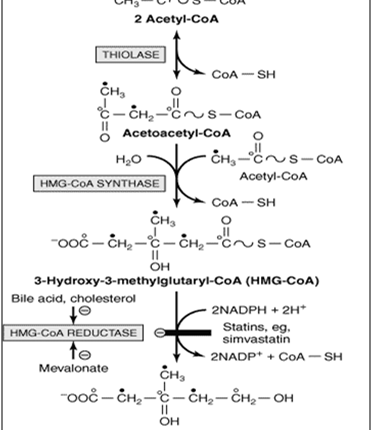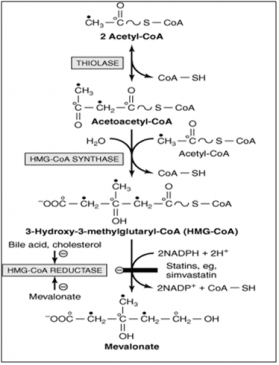Library
Biosynthesis of cholesterol- a quick revision
- March 21, 2020
- Posted by: Namrata Chhabra
- Category: Energy metabolism Learning resources Library Metabolism of lipids PowerPoint presentations PowerPoint Presentations Presentations Quick Revision Series Quick revisions USMLE Content

Biosynthesis of cholesterol
The biosynthesis of cholesterol may be divided into five steps:
(1) Synthesis of Mevalonate from acetyl-CoA.
(2) Formation of Isoprenoid units from Mevalonate by loss of CO2.
(3) Condensation of six isoprenoid units forms Squalene.
(4) The cyclization of Squalene gives rise to the parent steroid, Lanosterol.
(5)Formation of cholesterol from lanosterol.
Always remember the formula
2+2= 4
4+2= 6
6-1=5
5+5=10
10+5=15
2×15=30
30-3=27
Details- (See the figure-1 and 2)
i) 2+2= 4
- Initially, two molecules of acetyl-CoA (2+2) condense to form Acetoacetyl-CoA (4) catalyzed by cytosolic thiolase.
ii) 4+2=6
- Acetoacetyl-CoA condenses with a further molecule of acetyl-CoA (4+2) catalyzed by HMG-CoA synthase to form HMG-CoA that is reduced to Mevalonate (6) by NADPH catalyzed by HMG-CoA reductase (figure-1).

Figure-1- Reaction catalyzed by HMF Co A reductase. Statins inhibit HMG Co-A reductase by competitive inhibition and by bile acid, cholesterol, and Mevalonate by feedback inhibition
Significance
- The synthesis of Mevalonate is the committed step in cholesterol formation.
- The enzyme catalyzing this irreversible step, 3-hydroxy-3-methylglutaryl CoA reductase (HMG-CoA reductase), is an important control site in cholesterol biosynthesis,
- It is the site of action of the most effective class of cholesterol-lowering drugs, the HMG-CoA reductase inhibitors (statins).
iii) 6-1=5
- Decarboxylation (6-1 =5) yields Isopentenyl pyrophosphate (5), an activated isoprene unit that is a key building block for many important biomolecules (figure 2).
iv) 5+5=10
- Isopentenyl pyrophosphate Three by a shift of the double bond to form dimethylallyl pyrophosphate that condenses with another molecule of Isopentenyl pyrophosphate (5+5 =10) to form the ten-carbon intermediate Geranyl pyrophosphate (10).
v) 10+5=15
A further condensation with Isopentenyl pyrophosphate forms Farnesyl pyrophosphate (15).
v) 2×15=30
Two molecules of Farnesyl pyrophosphate (15+15) condense at the pyrophosphate end to form Squalene (30)
vi) 30-3=27
- Squalene can fold into a structure that closely resembles the steroid nucleus
- Before ring closure occurs, Squalene is converted to Squalene 2, 3-epoxide by a mixed-function oxidase in the endoplasmic reticulum, Squalene peroxidase.
- The methyl group on C14 is transferred to C13, and that on C8 to C14 as Cyclization occurs, catalyzed by oxidosqualene: lanosterol cyclase (figure-2).
The newly formed cyclized structure is Lanosterol.
- The formation of cholesterol from lanosterol takes place in the membranes of the endoplasmic reticulum and involves changes in the steroid nucleus and side chain.
- Three carbon atoms are lost.
- The double bond at C8–C9 is subsequently moved to C5–C6 in two steps, forming Desmosterol.
- Finally, the double bond of the side chain is reduced, producing cholesterol.

Figure-2- Steps of cholesterol biosynthesis
Further reading
Author:Namrata Chhabra
Leave a Reply Cancel reply
You must be logged in to post a comment.
